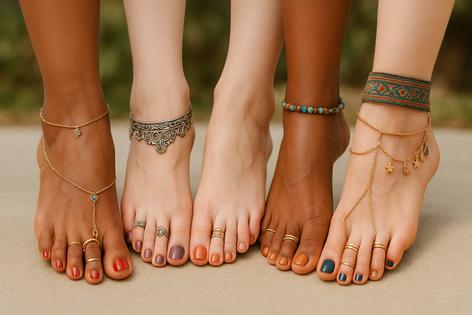Toe Rings, Anklets and Foot Fashion
Published in Fashion Daily News
In the ever-changing world of style, the feet have always carried a certain allure. From sparkling anklets to delicate toe rings, the ways people adorn their bare feet are as varied as the cultures that inspire them. Once considered primarily part of traditional dress, foot fashion has emerged as a growing trend in contemporary fashion scenes, blending cultural heritage with modern aesthetics.
Roots in Tradition
The story of foot adornment is ancient. In India, toe rings—called “bichiya”—have been worn for centuries, especially by married women, as a symbol of love, fertility and social status. Anklets, or “payal,” often jingled with small bells, were once thought to bring good luck and ward off negative spirits.
In Egypt, anklets were common among women of different classes, while in Greco-Roman societies, bare feet themselves often carried ritual or symbolic significance. Across Africa, intricate beadwork for the ankles and feet remains a hallmark of ceremonial attire. These traditions carried meaning beyond mere fashion: they spoke of identity, spirituality and belonging.
Modern Interpretations
In today’s globalized world, what began as cultural symbolism has become a style statement. Toe rings made of silver or minimalist gold bands now appear in beachwear catalogues and jewelry shops from Los Angeles to London. Anklets—ranging from delicate chains to bold charms—are worn casually with sandals or barefoot at music festivals.
Designers have increasingly embraced barefoot adornment in runway shows. High-fashion anklets paired with gowns, or stacked toe rings peeking from sandals, transform what was once seen as informal into a polished accessory. Even sports-inspired looks have welcomed anklets as a small but powerful detail.
The Bohemian Revival
The 1960s and 70s counterculture brought barefoot living back into mainstream consciousness, and with it, an appetite for simple adornments like leather anklets and woven friendship anklets. That bohemian spirit remains alive today. Music festivals such as Coachella or Glastonbury see an explosion of anklets, barefoot sandals made of beads or crochet, and layered toe rings that embrace the free-spirited vibe.
For many, going barefoot accessorized with jewelry isn’t just fashion—it’s a statement of connection to earth, nature and freedom. The jewelry enhances the act, framing it with intentional beauty.
Footwear Meets Jewelry
Not all foot fashion is limited to the completely barefoot. Designers now create “foot harnesses” or “barefoot sandals,” crafted from beads, lace or metal, that loop around the toe and ankle, giving the look of adornment without covering the sole. Brides at beach weddings often favor these, blending elegance with comfort.
Meanwhile, athletic footwear brands have also dabbled in anklet-inspired accents on sneakers, blurring the line between jewelry and apparel. The underlying idea: the foot is a canvas worth decorating, whether bare or in motion.
Global Celebrity Influence
As with many fashion movements, celebrities have helped push anklets and toe rings into the mainstream. Stars photographed on vacation in Capri or Ibiza often appear barefoot, with simple chains around their ankles or a ring glinting on a toe. Social media amplifies the effect, turning what once might have been dismissed as “beach trinkets” into aspirational accessories.
The runway, too, has embraced it. Designers from Chanel to Versace have included anklets in recent collections, sometimes extravagant, sometimes understated, always intentional. When high fashion adopts a symbol long considered casual, it often signals a shift in what is “in.”
Personal Expression
At its core, barefoot fashion is deeply personal. Anklets and toe rings invite play with identity: bold or delicate, gold or leather, jingling or silent. Unlike earrings or necklaces, they remain relatively subtle—often noticed only by those who take the time to look. That intimacy gives them a special charm.
For some, the appeal is simply aesthetic. For others, it connects to heritage, spirituality or lifestyle. Yogis, for example, sometimes wear toe rings or anklets as grounding symbols. Travelers pick up anklets as souvenirs, weaving stories into their style. Even in professional contexts, where formal footwear reigns, anklets often peek out as a reminder of individuality.
Challenges and Critiques
Like any fashion trend, barefoot adornment isn’t without critique. Some question whether the appropriation of cultural symbols—such as Indian toe rings—dilutes their meaning when sold purely as style. Others point out practical challenges: toe rings can be uncomfortable in closed shoes, anklets may catch on fabric.
Still, the enduring popularity suggests people are willing to navigate the practicalities for the sense of identity and beauty these adornments bring. For many, it’s less about trend and more about an ongoing tradition updated for modern life.
The Road Ahead
Fashion often circles back to the body itself—hair, hands, and now, feet. As minimalist styles remain popular, the subtle sparkle of a chain on the ankle or a ring on the toe continues to appeal. The rise of wellness culture, beach weddings, and barefoot-friendly events ensures anklets and toe rings won’t disappear anytime soon.
In a world saturated with fast-changing looks, foot adornment offers a timeless, intimate form of expression. A bare foot may be the canvas, but the jewelry transforms it into art—whether on a sunlit beach, a dance floor, or simply the quiet comfort of home.
========
This article was written, in part, utilizing AI tools.







Comments